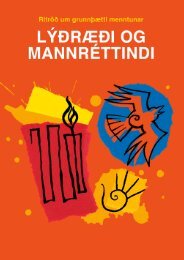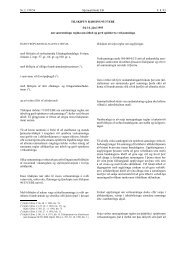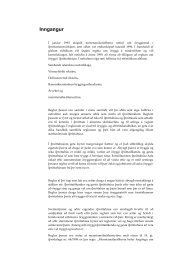Nomination of
Nomination of
Nomination of
You also want an ePaper? Increase the reach of your titles
YUMPU automatically turns print PDFs into web optimized ePapers that Google loves.
SURTSEY – NOMINATION FOR THE UNESCO WORLD HERITAGE LIST<br />
The vegetation in the Surtsey littoral zone is characterised<br />
by two distinct algal communities (see Fig. 2.16).<br />
(Photo: Karl Gunnarsson 1991).<br />
the shoreline which has a hard substrate and has<br />
also been accessible and therefore possible to<br />
examine is the eastern shore.<br />
Two algal belts are distinguishable in the littoral<br />
zone (Fig. 2.16): an upper belt, green in colour<br />
and dominated by the green algae Ulothrix<br />
flacca, Enteromorpha intestinalis and Urospora<br />
penicilliformis; and a lower belt dominated by<br />
brown-coloured species, among which Petalonia<br />
fascia, Petalonia zosterifolia, Scytosiphon<br />
lomentarius, Ectocarpus siliculosus and Porphyra<br />
umbilicalis (a brown-coloured red algae) are most<br />
common. At the lowest extreme <strong>of</strong> the littoral<br />
zone, the brown kelp species Alaria esculenta<br />
encroaches from the sublittoral zone, covering<br />
most <strong>of</strong> the rocks (Sigurður Jónsson et al. 1987).<br />
The littoral fauna is poor, although small crustaceans<br />
have been found amongst the filamentous<br />
algae, including the harpacticoid Harpacticus<br />
arcticus. The sessile animal most <strong>of</strong>ten observed<br />
in Surtsey's littoral zone is the acorn barnacle<br />
Semibalanus balanoides, which colonises the<br />
40<br />
χ 2 [%]<br />
100<br />
80<br />
60<br />
40<br />
20<br />
0<br />
1<br />
8 11 9 10 12 2 3 6 7 5 4<br />
No. <strong>of</strong> sample<br />
Fig. 2.16. Cluster analysis <strong>of</strong> samples from varying<br />
depths in the Surtsey littoral zone. Two communities<br />
can be distinguished: an upper one dominated by<br />
green algae and a lower one dominated by diatoms<br />
and brown algae. The numbers refer to sampling<br />
depths. Sample 1 is taken at low water mark at spring<br />
tide; sample 12 is taken at the highest water level.<br />
lower part <strong>of</strong> the littoral zone each spring, only<br />
to disappear the following winter. In summer tiny<br />
young mussels Mytilus edulis are also found in<br />
the littoral zone (Erlingur Hauksson 2000).<br />
In general, most plant species that have been<br />
identified in the littoral zone are annual species.<br />
All <strong>of</strong> the perennial species found were still in<br />
their first year and without exception disappeared<br />
again before the following spring. None <strong>of</strong> the<br />
large perennial fucoids dominating the mainland<br />
coast and rocky shores elsewhere in the<br />
Vestmannaeyjar archipelago were found to be<br />
growing in Surtsey until 1997, when a small<br />
Fucus spiralis plant from earlier the same summer<br />
was noted. No fucoid plants could be found upon<br />
examining the same site a year later (Sigurður<br />
Jónsson and Karl Gunnarsson 2000).<br />
Sublittoral zone<br />
The substrate in the sublittoral zone west, south<br />
and east <strong>of</strong> the island is made up <strong>of</strong> bedrock and<br />
boulders, <strong>of</strong>ten with sand in-between. In the



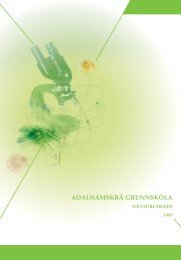
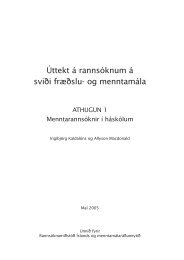

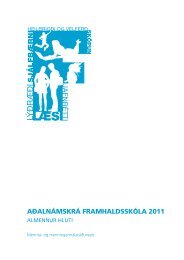
![Aðalnámskrá tónlistarskóla : rytmÃsk tónlist [Eingöngu á rafrænu formi]](https://img.yumpu.com/50843672/1/184x260/aaalnamskra-tanlistarskala-rytma-sk-tanlist-eingangu-a-rafranu-formi.jpg?quality=85)
